There are a lot of strands of wire in this gizmo for something with such a simple electrical system. I can imagine that more complex rigs look like a drunken Radio Shack vomited behind the wall-board. Still, running electrical is fun and fairly satisfying. Here's the upper raceway before it was all blocked in behind the cabinets:
The AC system is quite simple: a breaker in line with 3 plugs in series, the first being a GFCI, and the second powering a trickle charger for the 12V battery. The 12V system has a main breaker, a fuse box (below left) and a bus bar (below right). There are 5 existing circuits and 1 spare, as though I could ever stuff more wires anywhere:
- Galley 12V and USB plugs
- Cabin 12V and USB plugs
- Voltage tester
- Vent fan
- Lights
- ---
Not shown: the path for the primary wire from the raceways up through the galley, over the roof (on a 6" offset to the trailer left side, for future nailing and screwing reference), and out the front floor to the tongue box. I put the battery in the tongue box to save space in the galley.
Here's the first coat of paint on the interior! While painting, I realized, somewhat suddenly, that I'm almost done inside the cabin and the galley. Oh, don't worry, there's a lot to do yet. This little novel still has a few more chapters:
Just a lovely little space. See how simple the electrical system looks from the outside? The little flap opens up in the second tier down for the lower raceway, and a little door inside the cupboard allows fiddling in the upper one, in case I have the urge to go back into the bird's nests:
As of this moment, the interior ceiling has a coat of primer and 2 coat of paint. I believe I'll find the motivation for coat 3. The electrical is more or less done, but will need to be tested once everything is installed. There are some fiddly trim pieces to do, then it's onto the exterior! I'll dryfit the tongue box first, then start on the roof insulation and skinning.













